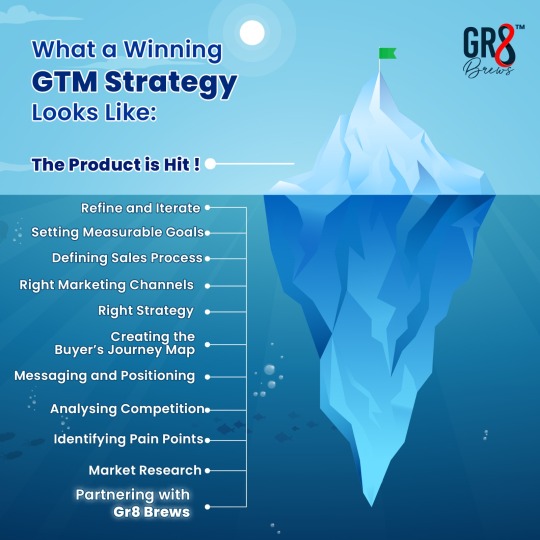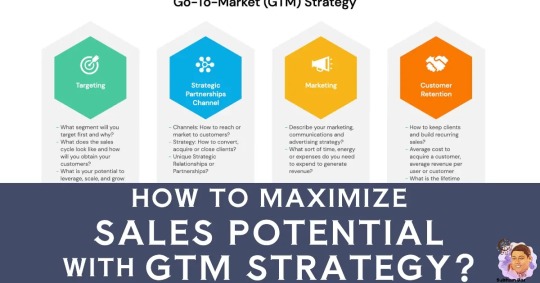#GTM Strategies
Explore tagged Tumblr posts
Text
The Power of Field Marketing: Deepika Vani’s Guide to Revenue Success
In the dynamic realm of B2B marketing, field marketing stands out as a pivotal strategy for driving revenue growth and fostering direct customer engagement. Deepika Vani, Senior Manager of Field Marketing at Whatfix, offers a comprehensive blueprint for achieving success in this arena. Her approach integrates data-driven initiatives, strategic event planning, and innovative engagement techniques to enhance brand visibility and accelerate pipeline growth.
The Evolution of Field Marketing in B2B
Field marketing has undergone a significant transformation, shifting from traditional event-centric tactics to a more integrated, data-driven approach. This evolution reflects the changing behaviors of B2B buyers, who now demand personalized and meaningful interactions. Modern field marketing focuses on creating experiences that resonate with target audiences, fostering trust and facilitating informed purchasing decisions.
Get full insights@ https://itechseries.com/interviews/field-marketing-success/
By aligning field marketing strategies with the contemporary B2B buying process, companies can enhance customer engagement and drive substantial revenue growth. This alignment necessitates a departure from broad-based approaches, emphasizing targeted, measurable, and integrated strategies that address the specific needs of potential clients.

Strategic Event Selection: Quality Over Quantity
One of the cornerstones of Vani's blueprint is the emphasis on strategic event selection. Rather than participating in numerous events, she advocates for focusing on those that align closely with the company's objectives and target audience. This selective approach ensures that resources are allocated effectively, leading to higher engagement and better returns on investment.
By prioritizing quality over quantity, businesses can create more impactful interactions, fostering deeper relationships with potential clients and partners. This strategy not only optimizes marketing expenditures but also enhances the overall effectiveness of field marketing initiatives.
Integrating AI for Enhanced Customer Engagement
Incorporating artificial intelligence (AI) into field marketing strategies can significantly enhance customer engagement. AI-driven tools enable marketers to analyze vast amounts of data, uncovering insights into customer preferences and behaviors. This information facilitates the creation of personalized marketing campaigns that resonate with specific segments, increasing the likelihood of conversion.
Moreover, AI can automate routine tasks, allowing marketing teams to focus on strategic planning and creative endeavors. By leveraging AI, businesses can deliver more relevant content, anticipate customer needs, and build stronger, more personalized relationships with their audience.
Aligning Marketing and Sales for Cohesive Strategies
A cohesive strategy between marketing and sales teams is vital for the success of field marketing initiatives. Vani emphasizes the importance of this alignment, as it ensures that both teams work towards common goals, share valuable insights, and present a unified message to potential clients.
Regular communication and collaboration between these departments can lead to a more streamlined approach, where marketing efforts are directly supportive of sales objectives. This synergy enhances the efficiency of the sales funnel, reduces friction in the customer journey, and ultimately contributes to increased revenue growth.
Leveraging Data-Driven Insights for Decision Making
Data-driven decision-making is at the heart of effective field marketing. By analyzing data from various touchpoints, marketers can gain a comprehensive understanding of what strategies work best, which events yield the highest engagement, and where improvements are needed. This analytical approach enables continuous optimization of marketing efforts, ensuring that resources are invested in the most impactful activities.
Furthermore, data insights can help identify emerging trends, customer pain points, and opportunities for innovation. By staying attuned to these factors, businesses can adapt their strategies proactively, maintaining a competitive edge in the market.
Explore the latest marketing and tech insights@ https://itechseries.com/gtm-library/
Embracing Virtual and Hybrid Event Models
The shift towards virtual and hybrid events has opened new avenues for field marketing. These models offer increased accessibility, allowing businesses to reach a broader audience without the constraints of physical location. Additionally, virtual events can be more cost-effective and provide valuable data on attendee engagement and behavior.
By integrating virtual components into traditional field marketing strategies, companies can create more flexible and scalable engagement opportunities. This approach not only caters to the preferences of modern buyers but also enhances the overall reach and impact of marketing initiatives.
Personalization: The Key to Customer Engagement
Personalization is a critical element in Vani's field marketing blueprint. Tailoring content and experiences to meet the specific needs and interests of target audiences can significantly enhance engagement and conversion rates. This strategy involves understanding the unique challenges and goals of potential clients and addressing them directly through customized marketing efforts.
Implementing personalization requires a deep understanding of customer data and the ability to translate insights into actionable strategies. By doing so, businesses can create more meaningful interactions, build trust, and position themselves as valuable partners in their clients' success.
Measuring Success and Continuous Improvement
To ensure the effectiveness of field marketing strategies, it is essential to establish clear metrics for success and regularly evaluate performance. This process involves setting specific, measurable goals, tracking progress, and analyzing outcomes to identify areas for improvement.
Continuous improvement is achieved by learning from past experiences, adapting to changes in the market, and implementing innovative approaches. By fostering a culture of ongoing evaluation and refinement, businesses can maintain the relevance and impact of their field marketing efforts, driving sustained revenue growth.
In conclusion, Deepika Vani's blueprint for field marketing success offers a comprehensive guide for B2B marketers aiming to enhance customer engagement and drive revenue growth. By focusing on strategic event selection, integrating AI, aligning marketing and sales, leveraging data-driven insights, embracing virtual events, personalizing interactions, and committing to continuous improvement, businesses can navigate the complexities of modern field marketing and achieve lasting success.
#Field Marketing#B2B Marketing#Revenue Growth#Marketing Strategy#GTM Strategies#Pipeline Acceleration#Customer Engagement
0 notes
Text

What will you be getting involved with From AUGUST 1st??
TELEGRAM@ Juneheale22
#trans pride#trans#transition#body dysmorphia#ftm t4t#ftm#gtm strategy#transgender#gender transition#trans sissy#gender affirming care#gay#trans memes#maletofemale#t4t#trans love
279 notes
·
View notes
Text

can we agree

on the efficacy of pull vs. push marketing?
0 notes
Text
The system is moving. Not just AI, not just business—intelligence itself is in play.
#AI Governance#Business Intelligence#Competitive Advantage#Cybersecurity Strategy#Data-Driven Strategy#digital transformation#Ecosystem Architecture#Ecosystem Orchestration#Emerging Technologies#future of work#GTM Innovation#hidden layer strategy#Intelligence Fabric#leadership#Monetization Strategies#Networked Intelligence#Non-Linear Value Creation#Preemptive Strategic Foresight#Silent Influence#silent influence in business#Strategic Inflection Point#Strategic Intelligence#System Design
0 notes
Text

We make your life easier, help you achieve your dreams, and make it all look effortless. You just sit back & trust the process.
Visit Us : https://www.gr8brews.com/
#advertising#branding#marketing#digital marketing#360marketing#social media marketing agency#gr8brews#brands#creativity#trending#gtm#gtm strategy
0 notes
Text
Time to shake things up! Your GTM strategy deserves better than the same old Salesforce playbook. It's all about breaking the status quo to stay ahead of the game.
Ready to revolutionize how you do business? Let’s talk innovation, not tradition!
1 note
·
View note
Text
The Secrets to a Successful Launch: GTM Strategy How to Increase Performance in Your Company

GTM strategy provides a roadmap that demarcates the business from its competitors and in the rapidly growing business realm, one cannot afford to launch into obscurity. For Devere Technologies, where we focus on simplifying convoluted procedures, it is notable that a smooth GTM is critical for any product or service.
This blog is your guide to getting it right on developing a proper GTM strategy. Here we will look into the constituent components, explain how it is done and provide you with information on how you can optimize your launch to achieve the greatest effect.
Demystifying the GTM Strategy: In America as in other parts, people should grasp the big picture or understand the context of the events or information they are exposed to.
Picture the following scenario of a detailed rocket launch. The final event that precedes the rocket’s launch is very accurately calculated to the tiniest detail: the fuel mix and the time, during which the rocket is launched. Just like in the case of Amazon, your GTM strategy also stems from a similar concept, though without a specific name. In simple terms, it is the strategic road map that gets your product or service offering, or even an entirely new business, to market efficiently and with direction.
A well-defined GTM strategy addresses several crucial questions.
Who do you want to reach or target with your product? It is important to have the best view of your target client.
What need does your offering address? State or explain the value proposition by trying to put into words who you — or more accurately, your product or service — are helping and how you are meeting their needs.
What are the modes of communication in getting the messages to the audiences? Determine communication techniques that could be used to reach your target buyers.
About the question above, what is your strategy for pricing? Set up the right pricing strategy that corresponds to the articulated value proposition and the industry environment.
How are you going to determine success? Identify the specific measures that you will be using to measure the success of your GTM strategy.
When answering these questions, you develop an action plan for your strategic venture’s launch and help your offering acquire the necessary market share.
Building Your GTM Arsenal:
Now that we understand the fundamentals, let's dig deeper into the key elements that make up a winning GTM strategy
1. Identifying Your Ideal Customer Profile (ICP):
The analysis of the target client base is one of the key prerequisites for the formation of an effective GTM strategy. Here's how to create a detailed ICP:
Demographics: Their age, income, geographical location, field of work, and position.
Firmographics: Organization type/size, annual sales and business segment (for products and services predominantly targeting the business-to-business market).
Needs & Pain Points: What are the general and specific problems that the population of your potential clients have?
Behaviors: How do they get Information? What consumption patterns do they have?
Goals & Aspirations: What is their purpose? Your offering will be most successful if it can explain how it will aid the consumers in achieving their objectives.
2. Crafting a Compelling Value Proposition:
Your value proposition is the key communication that clarifies what your product does and why it is significant to the target customers. Here's how to craft a compelling one:
Always communicate the benefit, not the feature. Try not to mention ‘features’ but rather think of how those attributes help your audience and ease their troubles.
I think comprehensibility, briefness and no ambiguity should also be taken into consideration. Do not use business-speak or trade industry language.
Carve out your niche in the market. Emphasize how your product/service is different from the rest and why people should go for it.
3. Choosing the Right Channels:
So the next time you hear a piece of communication advice like ‘the best communication is the second kind,’ or ‘the third time’s the charm,’ just remember that it can often take several attempts to get a message through.
One of the ways that can directly affect the firm's GTM strategy is the identification of the right channels required to communicate with the target consumers. Here are some factors to consider:
Target audience behaviour: where do they pass their time: offline and online?
Cost-effectiveness: Determine the cost per lead or cost per acquisition of each channel covered.
Content alignment: Always ensure that the message you are passing and the content in general go hand in hand with the channel in question.
Channel synergy: Think through an integrated way by which the various channels can be used to increase the disseminating audience.
Examples of channels include:
Content marketing: Anything on the blog, e-books, infographics and content shared on social media sites.
Email marketing: Email marketing that is more specific in this case of follow-up and conversion efforts to begin marketing leads.
Paid advertising: Include Google Ads and social media advertising to be able to cover more fans and followers.
Webinars and events: Perform informative and entertaining themed events online or in person to the targeted consumers.
Public relations: Ensure that there is good media coverage as this will help in enhancing the brand and its reputation.
4. Developing a Winning Pricing Strategy:
Pricing is always a significant determinant of an organization’s revenue besides determining the perception that customers have towards the product. Here are a few approaches to consider:
Value-based pricing: Set your price with the value that the customer will get from your offering.
Cost-plus pricing: Subtract the production costs and multiply the result with an intended profit margin.
Competitive pricing: When setting the price, it is also normative to look at competitors’ price levels and value offerings.
Freemium model: Deploy a free version with a different paid and more advanced version with additional accessories for a fee.
5. Measuring Success: Monitoring And Adjusting Your Progress
Signal your GTM strategy isn’t fixed. Entities do not ‘set and forget’ and are, instead, premier ongoing documents that must be altered according to the existing outcomes. Here's how to measure the success of your GTM strategy:
Define Key Performance Indicators (KPIs): Specify performance indicators that are relevant to the GTM strategy of the company. Some examples include:
Availability of the website and the leads generated
Metric of scale (such as signups for the free trial or purchase of the product)
Customer acquisition cost (CAC)
Customer lifetime value (CLTV)
Customers’ recognition of the brand and their activities on social media networks.
Track and Analyze Data: With analytics, KPI trends can be monitored and analyzed to understand the current state of your analytics.
Conduct A/B Testing: Experiment with the messaging, price points, or the web page where you would like the customers to end up.
Make Data-Driven Decisions: Make it a practice to quantify your GTM strategy and adjust your actions according to the results that benefit the company.
Bonus Tip: The focus of this article will be on the strategies for creating a buzz before a product is officially launched.
As the above proposals show, there are ways to build anticipation before the official launch and thus get a higher success rate. Here are some tactics to generate pre-launch buzz:
Create a landing page: Collect people’s e-mail addresses and to further engage them, reveal fragments of your works and other interesting information.
Engage on social media: Post the teasers, generate interest and communicate with the potential consumers.
Run influencer marketing campaigns: Engage the right influencer who would help you mark the word out about the offering you have.
Secure media coverage: Create press releases/advertorials and write press releases for your target media outlets.
The Road to Success: Implementation of Your GTM Strategy
Formulating this winning GTM strategy is a team effort. Here are some additional tips to ensure a smooth execution:
Cross-functional Collaboration: It should engage members of the marketing, sales, and customer success teams as well as the product development department.
Align with Business Goals: Your GTM plan should align with your organization’s goals & objectives.
Embrace Agility: Always be open to alterations to your strategy depending on the response of the market and the knowledge gathered.
Invest in the Right Tools: Integrate and leverage marketing automation, CRM, and sales enablement tools in your go-to-market strategies.
The steps highlighted above and the constant improvement of the strategies used can help make the right impact when launching your offering, which will determine continued success. And so, GTM plays a significant role in your blueprint for your business’s triumphant market entrance.
At Devere Technologies, we appreciate the logic of GTM strategies and creating and implementing them effectively. It is our experience and understanding of these processes together with our effectiveness as a DPI could be very useful for entry and achieving the required revenues for a business regardless of its size. If you have a plan to develop a new product, service or business, you can get in touch with Devere Technologies today and we can show you how to have a splendid market entry.
0 notes
Text
Go-to-Market Strategy Checklist: Key Steps for Success

This infographic outlines the essential steps for a successful go-to-market (GTM) strategy, from market research and positioning to marketing execution. Follow this checklist to launch your product or service effectively and drive growth. Learn more at AndPurpose.
0 notes
Text
The Ultimate Google Tag Manager Course: Beginner to Advanced
Introduction
In today’s digital landscape, managing and analyzing marketing tags efficiently is crucial for optimizing marketing efforts and tracking user interactions accurately. Google Tag Manager (GTM) offers a powerful, user-friendly platform to streamline this process. This course is designed to take you from a beginner to an advanced user of GTM, helping you harness its full potential for your digital marketing needs.
Getting Started with Google Tag Manager
Setting Up a GTM Account
To begin using GTM, you'll first need to set up an account. Visit the GTM website, sign up with your Google account, and create a new container for your website. This container will hold all your tags, triggers, and variables.
Understanding GTM Interface
The GTM interface is divided into several sections: Tags, Triggers, Variables, and Data Layer. Familiarizing yourself with these sections will help you navigate GTM efficiently and manage your tags effectively.
Basic Terminology
Understanding basic GTM terminology is essential. Key terms include Tags (pieces of code for tracking), Triggers (conditions for firing tags), and Variables (dynamic values used in tags and triggers).
Creating Your First Tag
What is a Tag?
A tag is a snippet of code used to collect and send data to third-party services like Google Analytics. Tags can track various user actions, such as page views or clicks.
How to Create a Tag
To create a tag, go to the "Tags" section in GTM, click "New," and choose the tag type you want to implement. Follow the prompts to configure the tag settings and link it to the appropriate triggers.
Common Tag Types (e.g., Google Analytics, AdWords)
Common tags include Google Analytics for tracking user behavior, AdWords for measuring ad performance, and Facebook Pixel for tracking social media interactions. Each tag type has specific configurations based on the platform.
Understanding Triggers
What are Triggers?
Triggers determine when and how tags should be fired. They listen for specific user actions or events on your site, such as page loads or button clicks.
Types of Triggers (e.g., Page View, Click, Form Submission)
Types of triggers include Page View (fires when a page is loaded), Click (fires when an element is clicked), and Form Submission (fires when a form is submitted). Each type can be customized to meet your tracking needs.
Creating and Configuring Triggers
To create a trigger, go to the "Triggers" section in GTM, click "New," and select the trigger type. Configure the trigger settings based on the specific action you want to track.
Variables in GTM
What are Variables?
Variables are used to store dynamic values that can be used in tags and triggers. They help customize your tags by providing contextual information.
Types of Variables (e.g., Built-In, User-Defined)
Built-In Variables are pre-configured by GTM and include values like Page URL and Referrer. User-Defined Variables are custom variables you create, such as capturing user ID or form field values.
Using Variables to Enhance Tags and Triggers
Variables can be used to pass dynamic data to your tags or to define more specific conditions for your triggers. For example, you might use a variable to track user-specific actions based on their behavior on your site.
Data Layer Fundamentals
What is the Data Layer?
The Data Layer is a JavaScript object that stores and passes information to GTM. It acts as a bridge between your website and GTM, allowing you to push data into GTM for use in tags and triggers.
Implementing the Data Layer
To implement the Data Layer, add a JavaScript code snippet to your website that initializes and pushes data into the Data Layer object. This setup allows GTM to access and use the data.
Using Data Layer Variables in Tags
Data Layer Variables are used to retrieve values from the Data Layer and use them in your tags. For example, you can use a Data Layer Variable to capture a user’s membership level and send it to Google Analytics.
Advanced Tag Management
Custom HTML Tags
Custom HTML Tags allow you to add custom JavaScript or HTML code to your site. They offer flexibility for tracking unique events or integrating third-party services not covered by standard tag templates.
Custom JavaScript Variables
Custom JavaScript Variables enable you to write and use custom JavaScript code within GTM. These variables can perform complex calculations or retrieve data from external sources.
Tag Sequencing and Firing Rules
Tag Sequencing ensures that tags fire in a specific order. For example, you might want your Google Analytics tag to fire before a conversion tracking tag. Set up firing rules to control the sequence of your tags.
Debugging and Testing
Using GTM Preview Mode
Preview Mode allows you to test and debug your GTM setup before publishing it. You can see which tags are firing, which triggers are being activated, and check for any issues.
Common Debugging Techniques
Use the GTM Debug Console to identify problems, such as tags not firing or triggers not being activated. Look for errors in the JavaScript console and verify your Data Layer implementation.
Testing Tags and Triggers
Thoroughly test your tags and triggers to ensure they are working as expected. Use tools like Google Tag Assistant to verify that tags are firing correctly and data is being sent accurately.
Event Tracking with GTM
Setting Up Event Tracking
Event Tracking allows you to monitor user interactions, such as clicks, downloads, and form submissions. Set up event tracking by creating event tags and triggers in GTM.
Tracking User Interactions (e.g., Clicks, Downloads)
Configure triggers to track specific user interactions, such as button clicks or file downloads. Create tags to capture these events and send the data to your analytics platform.
Creating Custom Events
Custom Events enable you to track unique user actions that are not covered by standard event tracking. Define custom events in GTM and use them to measure specific interactions on your site.
0 notes
Text
Driving Growth Through GTM and Innovation: Mandeep Taunk’s Journey
Navigating the complex landscape of Go-to-Market (GTM) strategies in B2B marketing requires a blend of creativity, foresight, and technical expertise. Mandeep Taunk, a seasoned leader in product marketing and entrepreneurship, offers invaluable insights into crafting GTM strategies that drive growth, foster innovation, and align teams for success. In this blog, we delve into key lessons from Mandeep’s expertise.
What Makes a Winning GTM Strategy?
A robust GTM strategy is the foundation of successful product launches and market penetration. Mandeep emphasizes that a clear value proposition is the cornerstone of an effective GTM plan.
Get full insights@ https://itechseries.com/interviews/gtm-insights-from-mandeep-taunk/
In B2B marketing, understanding the pain points of target audiences and addressing them directly is critical. By aligning your product messaging with customer needs, you establish trust and differentiate your offering from competitors.
The Intersection of Leadership and Marketing
Leadership strategy plays a pivotal role in the execution of GTM strategies. Mandeep advocates for empowering cross-functional teams to foster collaboration and innovation.
When leaders prioritize open communication and shared goals, it becomes easier to align marketing, sales, and product teams. This alignment not only accelerates time-to-market but also ensures consistency in messaging across channels.

The Role of Technology in Modern GTM Strategies
In today’s digital age, technology is a critical enabler of GTM success. From customer relationship management (CRM) tools to data analytics platforms, technology streamlines operations and provides actionable insights.
Mandeep suggests leveraging advanced tools to gain a 360-degree view of customer behavior. These insights enable B2B marketers to create personalized campaigns that resonate with specific audience segments.
Entrepreneurship and GTM: What Can We Learn?
Entrepreneurs often face unique challenges in bringing products to market. Mandeep highlights the importance of agility and adaptability in these scenarios.
Startups and small businesses can benefit from a lean GTM approach, focusing on core strengths and iterating based on market feedback. This entrepreneurial mindset ensures continuous improvement and alignment with customer needs.
Explore the latest marketing and tech insights@ https://itechseries.com/gtm-library/
Building Cross-Functional Teams for GTM Success
A successful GTM strategy relies heavily on cross-functional collaboration. Mandeep underscores the importance of creating teams that integrate expertise from marketing, sales, and product development.
When teams work together towards shared objectives, they can identify opportunities, mitigate risks, and execute campaigns more efficiently. This unified approach fosters a culture of innovation and accountability.
Why Product Marketing is Central to GTM Strategies
Product marketing bridges the gap between product development and customer engagement. Mandeep views product marketers as the architects of GTM strategies, responsible for translating technical features into compelling benefits.
By conducting market research and competitive analysis, product marketers can craft messages that resonate with B2B audiences. Their role is instrumental in ensuring that the product aligns with market demand.
How to Align Leadership Strategy with Market Needs
Effective leadership involves balancing long-term vision with immediate market demands. According to Mandeep, leaders must remain customer-centric while driving innovation within their teams.
By fostering a culture of continuous learning, leaders can adapt their strategies to evolving market trends. This adaptability is key to sustaining relevance in a competitive B2B landscape.
Lessons from Mandeep: The Future of GTM Strategies
Looking ahead, Mandeep predicts that data-driven decision-making and personalization will continue to shape GTM strategies. Businesses that invest in advanced analytics and AI-powered tools will gain a competitive edge.
Moreover, Mandeep stresses the importance of ethical marketing practices. Transparency and authenticity are essential in building lasting relationships with B2B customers.
Conclusion
Mandeep Taunk’s insights offer a roadmap for navigating the intricate world of GTM strategies, entrepreneurship, and product marketing. By focusing on customer needs, leveraging technology, and fostering collaboration, B2B marketers can drive growth and achieve long-term success.
#GTM Strategies#Product Marketing#Growth Marketing#B2B Leadership#Product Market Fit#AI#Lead Generation
0 notes
Text
Via Marketing
Website: https://viamrkting.com/
1 note
·
View note
Text

Looker Studio Reporting
for AocJobs
#looker studio#looker#google ads#googleads#google analytics#google tag manager#data studio#google data studio#ga4#gtm strategy#mafujibrahim
1 note
·
View note
Text
GTM Strategy for Efficient Sales and Marketing
Elevate your go-to-market strategy with advanced techniques, leveraging data-driven decision-making, automation, and Account-Based Experience (ABX) for efficient sales and marketing. Continue reading to learn more. Advanced GTM Strategy TechniquesData-Driven Decision-MakingAutomationAccount-Based Experience (ABX)Best Practices for a Successful GTM StrategyKey FacetsStakeholder…

View On WordPress
#business strategy#sales#startup#GTM strategy#go-to-market strategy#sales and marketing#efficient sales#marketing strategy#sales optimization#market entry#sales growth#revenue growth#customer acquisition#sales process#marketing plan#business growth#market research#sales tactics#marketing tactics#market penetration#sales funnel#marketing funnel#lead generation#customer journey#target market#marketing alignment#sales alignment#GTM plan#product launch#sales strategy
1 note
·
View note
Text
How to Create a Custom GTM Strategy by Asking the Right Questions? How to create a custom Go-to-Market strategy for your product’s success by addressing the right questions

0 notes
Text
FMCG Business Strategy: Comprehensive Guide for Sustainable Growth
Explore the intricacies of FMCG business strategy for sustainable growth. Discover key components like product innovation, pricing, distribution, and successful case studies in this guide.
#FMCG Business Strategy#Fast-Moving Consumer Goods#FMCG#FMCG companies#FMCG business strategy#FMCG business#Go-To-Market strategy#GTM strategy#FMCG products#Digital marketing#FMCG industry#Go-To-Market Strategy Consulting#Go-To-Market strategies#FMCG consultancy firms#FMCG Pricing Strategy#FMCG consultants#CPG Consulting firms#Strategii At Work
0 notes
Text
Challenges that marketers face during AI adoption
Interesting read on Marketing challenges.
As marketers embrace the transformative power of artificial intelligence (AI), they encounter various challenges that come with integrating this advanced technology into their strategies. Here are 10 challenges that marketers commonly face with AI: Data Quality and Integration: Challenge: AI relies heavily on data, and ensuring the quality, accuracy, and integration of diverse data sources can…

View On WordPress
0 notes